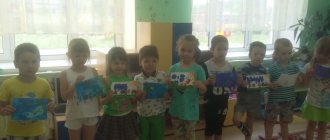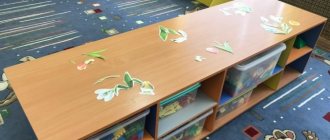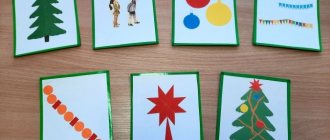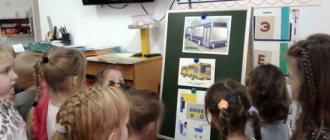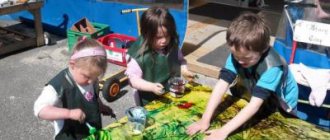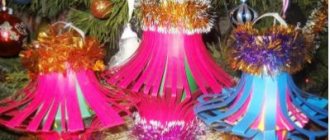Preview:
Goal: formation of artistic and creative abilities.
— create conditions for consolidating children’s knowledge about non-traditional artistic techniques of drawing and appliqué;
- create conditions for children to convey characteristics and expressiveness using the color of magical flowers;
— create conditions for the ability to find non-standard solutions to creative problems;
— create conditions for improving fine motor skills of the hands;
— create conditions for enriching vocabulary and activating adjectives in children’s speech;
- create conditions for the development of the emotional and sensory sphere of children.
Vocabulary: alarming, magical, exclamatory, travelers.
Equipment: a square of white paper, gouache, brushes of different sizes, a jar of water, glue, scissors, large and small squares of colored paper, a simple pencil, napkins. Panel "Magic Tree". Musical accompaniment.
— acquaintance with non-traditional artistic drawing techniques, examination of samples;
- drawing decorative flowers, examining them in the products of folk craftsmen.
The teacher and the children enter the group and greet the guests.
The teacher gathers the children around him. Loud knock on the door. The teacher asks the children:
- Who could it be, who is knocking so loudly on our door?
Children's answers (postman, guest, surprise, etc.)
They come to a consensus. The teacher goes to the door, opens it and finds an envelope. Plays, if you guessed right, says:
- Guys, you guessed wrong, you see an envelope here.
Educator: I wonder who the envelope is from, what do you think?
Educator: an envelope from the good sorceress. I wonder what is in the envelope, what do you think?
The teacher opens the envelope and takes out a letter. Asks a question to the children:
- Why is it like this, all in exclamation marks? Do you think the letter is alarming or joyful?
When they say something alarming, he asks:
- Why such a disturbing letter?
Children: The good sorceress asks for help! Something happened!
The teacher invites the children to sit on the carpet and listen to the letter sent by the good sorceress.
- I am a good sorceress. Among the many wonders that surround me, there is a magical garden where an extraordinary, magical tree grows. And now this tree will appear here.” The teacher opens a panel with a tree, which is on an easel, covered with a cloth, and the children examine it. The teacher reads further:
Educator: Children, who are travelers?
Children: People who travel, who are on the road for a long time.
“But this spring the flowers did not bloom.”
Educator: Why do you think?
— The evil sorceress also has a garden, but the trees bloom with dark, prickly, ugly flowers. She was jealous of the beauty of this tree and decided: Since I don’t have such a beautifully flowering tree, then let no one have it! And now this tree doesn’t bloom!
- I ask you for help. Help me disenchant my tree!
Educator: Children, can we help the good sorceress?
Children: Yes, we will help!
Educator: How can we help the good sorceress?
Children: Let's draw flowers and the tree will bloom!
Educator: You and I will become wizards and draw magical, beautiful flowers
The teacher invites the children to sit at the tables, the children examine the materials prepared for drawing.
Educator: What magical drawing methods do you know?
Children: We can paint with our fingers, applying a brush to paper, with cotton swabs.
The teacher asks 3-4 children about what magical ways they will draw beautiful, magical, unusual flowers.
Finger gymnastics “Flowers”
Our scarlet flowers (Slowly extend your fingers from your fists, shaking your hands left and right)
The breeze breathes a little
The petals are swaying. (Slowly clench your fingers into fists and rock your fists back and forth)
So, guys, you have chosen the ways in which you will draw magical, bright, beautiful flowers. Now we can start working in our magic workshop.
Children draw, light, quiet, magical music sounds. The teacher conducts individual work. At the end of the work the teacher says:
-Guys, we are finishing our magic!
Children, having finished drawing, hang their work on a tree.
Educator: Varya, find Christina’s flower and tell me what it is (bright, unusual, magical, beautiful).
The teacher asks 2 more children.
Educator: Really, what a beautiful tree we got!
-Educator: Do you think we helped the sorceress?
Educator: What great fellows you are!
Educator: Let us sit under this tree as travelers, and feel goodness, good mood and pass it on to each other. Now we are all in a good mood, let's share it with our guests!
The guys sit under the magic tree and transmit air breezes from their palms to the guests. The lesson ends.
Source
Senior group. Senior preschool age. Children 5-6 years old
Summary of a drawing lesson using ICT “Ossetian Tower” for children of senior preschool age “Innovative computer technologies in working with children of senior preschool age” Topic “Ossetian Tower”
Goal: To introduce children to the history of their native land. • Introduce the purpose of Ossetian towers. • Develop fantasy and imagination, improve visual perception.
Summary of the drawing lesson “Christmas card” in the senior group Goal: • Stimulate the development of children’s creative abilities in the process of mastering Christmas traditions on the Don; Integration of educational areas: “Cognitive development”
,
“Artistic and aesthetic development”
,
“Speech development”
,
“Social and communicative development”
.
Summary of an open lesson on drawing in a preparatory group using the scratch technique
Summary of an open lesson on drawing in a non-traditional scratch paper technique on the topic “Underwater World” for the regional methodological association.
Author: Nadezhda Viktorovna Vinogradova, teacher at GBDOU d/s No. 14, St. Petersburg. Description: I offer you a summary of an open lesson in a preparatory school group. This material will be useful to teachers and methodologists of preschool institutions. Goal: drawing on the theme “Underwater World” using the non-traditional technique “scratchboard” Objectives: To strengthen technical drawing skills in children. Continue to learn how to build a composition of a drawing, reflect your impressions and knowledge about the world around you in a drawing. Develop children's imagination and creativity. Methods and techniques: playful, verbal (conversation), visual, practical, unconventional drawing. Materials and equipment for the lesson: sheets of thick paper specially primed for making drawings using the scratch paper technique (first the entire surface of the cardboard is carefully painted with wax crayons of different colors, then the cardboard is covered with a layer of blue gouache, after complete drying the cardboard is ready for drawing), toothpicks, illustrations of sea inhabitants, puzzles (cut photographs of sea animals and fish in A4 format), audio recordings: A. Kanachyan - “In the blue sea, in white foam”, the sound of the surf.
Diving accessories: fins, masks, goggles, snorkels, “the gate of the sea Tsarstav”: a screen with blue drapery. For a relaxation corner: a bath with sand and pebbles and shells hidden in it. Course of the lesson
1. Introductory part: Conversation The song by A. Kanachyan “In the blue sea in white foam...” is played, the children enter the hall. The music stops. Educator: - Guys, today is an unusual day for us, guests have come to us, let's say hello to them (Hello!) - Now let's move on... Look, what is this lying here? What is this for? (Children look at the objects on the green “island” on the floor, offer possible answers: mask and snorkel for diving, fins, inflatable ring, etc.).
- Where is all this used, on land or in water? (in the water) - So, where will we travel today? (in the sea) - That's right, in the depths of the sea. We have already met some of the inhabitants of the underwater world. Let's remember them (the teacher takes the children to a stand with images of fish and sea animals).
Children list, pointing to pictures, those fish and animals they know, remember their habits and characteristics. The teacher draws attention to the shape and color of the sea inhabitants, as well as to the fact that there are plants in the sea - algae - and they are also all different in shape and color. The teacher asks about those who were not named: “Who do you think it is?” Who does he look like? (Children make assumptions, the teacher corrects, naming correctly) 2. Puzzles The teacher turns to the center of the hall, where there is a “lake” (blue fabric in the shape of a circle) on the floor, draws the children’s attention to it and what lies in it: - Guys , what do we have here? It looks like a pond, and there is sea mail in it, look - envelopes! Take an envelope each and let's see what's inside? - Oh, yes, there are photographs of someone, but they are not whole, but divided into parts... We need to make photographs from these pieces, then we can find out whose they are.
Children sit/lay down on the “lake”, put together puzzles, and discuss who has whose photo. Educator: - Thank you guys, now underwater inhabitants can easily find their photos.
3. Riddles Educator: - Do you know that we have an oceanarium in St. Petersburg? Have any of you been in it? If you haven’t been, I highly recommend visiting with your parents. It's so interesting there! You can meet amazing fish and sea animals, examine the seabed and various underwater plants. Guess who I met there? This fish is an evil predator It will swallow everyone headlong It yawned showing its teeth And went to the bottom... (shark) A pear with long legs Settled in the ocean As many as eight arms and legs This is a miracle -... (octopus) For himself at the bottom of the sea He builds a house with his claws A round shell , ten paws Did you guess it? This is... (crab) What kind of ball floats with spikes, Quietly waving its fins? You just can’t take this ball in your hands - ... (hedgehog fish) Both on land and in water Carries the house with it everywhere Travels without fear In this house ... (turtle) A transparent umbrella floats “I’ll burn you!” – threatens – Don’t touch! She has paws and a belly. What is her name? (jellyfish) She looks so much like a horse And she also lives in the sea That’s how the fish is! Jump and jump - The sea horse is jumping... (horse)
4. Physical education lesson Educator: Somehow, we guys stayed too long. Let's warm up a little. Waves splash in the ocean (alternately swing your right and left hands) What seems to be there in the fog? (raise your palm to your forehead, “peering”) These are the masts of ships (raise your straight arms up) Let them sail here quickly! (swing your arms left and right from the elbow) We walk along the shore, (step in place) We wait for sailors, We look for shells in the sand (bend over, reach the floor with our hands) And clench them in our fists (raise clenched fists) To collect more of them (squats) I need to squat more often
5. Main part: Educator: - Guys, would you like to meet underwater inhabitants and make a photo drawing of them? What do we need to do for this? (dive under the water) - Children, look what’s in the basket here? (masks for scuba diving). Why are they needed, remind me? (to see under water) - These are the ones that will be useful to us now. Let's put them on and dive in! Before diving, take a deep breath and hold your breath a little. Children put on masks and “dive” into the makeshift gates of the “Sea Kingdom”. The teacher invites them to sit down at the prepared workstations and take off their masks.
Educator: - Guys, we have now dived into the underwater world. Let's close our eyes and imagine the seabed and underwater inhabitants (turn on the audio recording “sound of the surf”). Look at them carefully: who you saw, what size, color, what surrounds them, remember them. Open your eyes and let's take a photo of what you just saw. We won’t tell you yet who we met, but when you draw, then we’ll try to guess. And today we will draw using the grattage technique. We are already familiar with this technique. What else can you call it, how do we apply the drawing? (scratch). The underwater world is a world of magical beauty, it is very colorful. Everything in it mysteriously shimmers with different colors, and some animals even know how to change their color themselves (octopus). Therefore, for today’s sketch for each of you, I made this small sea with a colored base, there is already water in it, you just need to populate it with inhabitants and plants. Choose the size of your future photo drawing (children choose the format of the blank). — Let's remember once again how to draw using the grattage technique (scratch a design with a toothpick on a workpiece). A toothpick is a tool, be very careful and attentive with it. Now imagine again what you want to draw and get started. If anyone needs help, call me quietly so as not to put water in your mouth and scare away the fish.
Children, under the supervision of a teacher, draw a composition on a marine theme.
The child with the finished work puts on a mask and “surfaces”, the teacher directs him to a relaxation corner (a bath filled with sand with “surprises” - the game “find a sea souvenir”). At the end of the lesson, children's works are filed in a common “photo album”.
6. Final part: Educator: - Guys, our album of “photo drawings” is ready, let’s look together, admire and try to guess who met whom under water. Children, together with the teacher, look at the album, discuss the work, and guess what is depicted. -Did you enjoy today’s trip to the Sea Kingdom? You are so great: you talked about swimming accessories, solved riddles, guessed the inhabitants from pictures and made a whole Sea Album! Let's leave it to our guests to watch, and we ourselves will go and refresh ourselves, a second breakfast awaits us. The children leave the hall to the continuation of A. Kanachyan’s song “In the blue sea, in the white foam...”.
Children's works
We recommend watching:
How to draw a winter tree Decorative art “Encaustic” + MK Non-traditional painting using the Spray technique on the theme: Winter Technique Scratchboard for preschoolers
Similar articles:
Master class for preschool teachers. Unconventional drawing techniques
"Wet" drawing technique
Parents about non-traditional drawing techniques
Application with drawing elements
Non-traditional drawing techniques in kindergarten for children 5-6-7 years old
